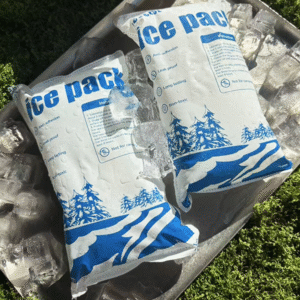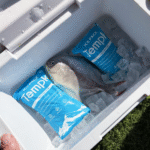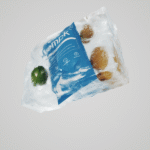Extra Cold Dry Ice Pack: Cara Pengiriman Frozen yang Benar
You want frozen products to arrive rock‑solid without paying for waste. Sebuah extra cold dry ice pack is your most reliable tool to keep goods below –18 °C during long transits. Dalam panduan ini, you’ll learn how to size it, pack it, and handle it safely. Anda juga akan melihat 2025 best practices that reduce cost and emissions while protecting quality.
-
How does an extra cold dry ice pack work to keep sub‑zero stability?
-
How much dry ice do you need for 24–96 hours, and what affects hold time?
-
What’s the safest way to pack out and vent the box for CO₂ release?
-
When to choose dry ice vs gel packs vs PCM for frozen shipping?
-
2025 tren: bahan, peraturan, and sustainability in frozen logistics.
What is an extra cold dry ice pack and when should you use it?
An extra cold dry ice pack keeps product below freezing by absorbing heat as the CO₂ solid sublimates at –78.5 °C. Use it when your lane or product needs sub‑zero protection beyond what gel packs or standard PCM can deliver. It shines for frozen foods, es krim, Biologi, dan bahan kimia khusus, especially for 48–96‑hour deliveries or uncertain last‑mile conditions.
Think of dry ice like a “cold battery” with high capacity. Each kilogram provides about 571 kJ of cooling as it turns into gas. That’s powerful enough to recover from door‑open delays and hot depots. If your shipments face heat spikes, sebuah extra cold dry ice pack gives you margin that gel cannot. It also prevents refreezing cycles that can damage texture and cells in sensitive items.
What makes a dry ice solution “extra cold” vs regular gel?
“Extra cold” refers to temperature capability and cooling capacity rather than a brand name. Dry ice runs at –78.5 °C, far below gel formulations. The result is faster pull‑down and stronger freeze maintenance. A carefully placed extra cold dry ice pack on top of the payload can hold a frozen core while outer layers buffer heat. For goods that must remain <–20 ° C., the extra headroom is valuable.
| Opsi Pendinginan | Nominal Temp Band | Energy per kg | Apa artinya bagimu |
|---|---|---|---|
| Es kering (Co₂, padat) | –78.5 ° C. | ~571 kJ/kg | Deep‑freeze control, terbaik untuk dibekukan; needs venting and UN 1845 pelabelan |
| Gel ice | 0 °C to –5 °C | Rendah | Good for chilled, not for long frozen holds |
| PCM (–21 °C) | ~–21 °C plateau | Sedang | Stable frozen range; limited recovery from heat spikes vs extra cold dry ice pack |
Tips praktis yang dapat Anda gunakan sekarang
-
Use top‑loading: Tempatkan extra cold dry ice pack above the payload. CO₂ gas sinks, washing cold over the product.
-
Leave vent paths: Never seal gas tight. Vent holes or a loose lid prevent pressure build‑up.
-
Sarung tangan dan pelindung mata: Handle with insulated gloves to avoid frostbite and add goggles for chip‑out work.
Contoh dunia nyata: A meal‑kit brand upgraded to an extra cold dry ice pack top‑load and added a vented lid. Failures dropped from 6.8% ke 0.9% over summer peaks, with average product core >10 °C colder on arrival.
How much extra cold dry ice pack do you need for your lane?
Start with your heat load, then translate to kilograms of dry ice. A quick field rule: for a 24‑hour hold in a 12–24 L EPS cooler shipping frozen food, many shippers start around 2–4 kg. For 48–72 hours, 4–8 kg is common. The right number depends on insulation (Nilai -R), ukuran kotak, ambient peaks, and how often the parcel is opened.
A simple way to estimate is to add product pull‑down (if not already frozen), packaging heat leak, and a safety margin. Because dry ice provides high energy per kg, sebuah extra cold dry ice pack can reduce total mass compared with stacking gel bricks. Always validate with test shipments and a temperature logger.
Quick calculation with a safety buffer
Step‑by‑step approach you can adapt:
-
Estimate heat leak (Q̇): Box U‑value × surface area × average ΔT.
-
Multiply by time: Q = Q̇ × hours (convert to kJ).
-
Add product pull‑down: If starting above target, include the energy to freeze or cool.
-
Add 20–30% buffer: Covers handoffs, re‑sorts, or weekend holds.
-
Divide by 571 kJ/kg: That’s your first‑pass kilograms of extra cold dry ice pack.
| Lane Duration | EPS 1.5″ Wall | EPS 2.0″ Wall | Apa artinya bagimu |
|---|---|---|---|
| 24 jam | 2–3kg | 1.5–2.5kg | Start small and validate with two loggers |
| 48 jam | 4–6kg | 3–5kg | Add buffer if last‑mile is hot |
| 72 jam | 6–9kg | 5–7kg | Consider dual‑layer extra cold dry ice pack |
| 96 jam | 8–12kg | 7–10kg | Move to VIP panels or hybrid PCM + es kering |
Pack‑out pattern that improves hold time
Use a top layer of dry ice, side runners if volume allows, and a small bottom pad only when necessary. Keep a gap between the extra cold dry ice pack and direct product contact using a corrugate sheet. Gas needs room to flow. For fragile cartons, wrap the pack in kraft paper to avoid cold shock.
How long will an extra cold dry ice pack last in transit?
Hold time depends on insulation, ambient spikes, and mass of dry ice. In stable conditions, a tight shipper can lose 5–10% mass per hour initially, then slow as internal temperature drops. With larger masses, sublimation becomes steadier and the payload sees fewer swings. For 48‑hour lanes in summer, many teams plan for mid‑range estimates and test worst‑case hot profiles.
Weather and depot dwell drive the biggest surprises. A extra cold dry ice pack counteracts brief heat spikes, but extended truck dwell at 35–40 °C will eat capacity quickly. Add buffer when sending before a weekend or holiday, and use “do not freeze” indicators for any chilled‑plus items in a mixed load.
Reading a temperature logger the smart way
Look for early thaw warnings and the inflection when the dry ice is gone. As long as any extra cold dry ice pack remains, payload air often stays below –50 °C near the pack. Once it’s gone, the curve climbs faster. If the logger shows a plateau ending well before delivery, increase dry ice or improve R‑value.
| Logger Signal | What you see | Likely Cause | Apa yang harus diubah |
|---|---|---|---|
| Early plateau end | Sudden rise after 12–18 h | Too little dry ice | Tambahkan 20–30% extra cold dry ice pack |
| Saw‑tooth swings | Temp oscillates ±5–10 °C | Loose pack‑out | Isi kekosongan; add side runners |
| Gradual warm trend | Steady 0.5–1 °C/h rise | Insulation leak | Upgrade to 2″ EPS or VIP |
Is your extra cold dry ice pack packed safely and compliantly?
Dry ice is UN 1845 “Karbon dioksida, solid” and must be vented, berlabel, and limited by mode. Use insulated gloves and eye protection. Never store in an airtight container or vehicle trunk. Untuk pengiriman udara, follow current DGR requirements for net mass per package, tanda, and shipper’s declaration when applicable. On the parcel, mark net dry ice weight and ensure gas can escape.
For workplace safety, ventilate storage rooms and vehicles. CO₂ lebih berat dari udara dan dapat menggantikan oksigen. Train staff to identify frostbite risks and to use scoops or tongs. A well‑designed extra cold dry ice pack program includes SOPs, APD, and a spill plan for chips.
Vented packaging and labels done right
Use a lid that “breathes,” label UN 1845, and list net kilograms. Insert a simple “open with care” card near the extra cold dry ice pack so recipients avoid cold burns. If your payload cannot be frozen, create a barrier with PCM panels and place dry ice in a separate compartment.
| Persyaratan | Mengapa itu penting | Bagaimana cara melakukannya | Untukmu |
|---|---|---|---|
| Ventilasi | Mencegah penumpukan tekanan | Vented lid or gas path | Safety and compliance |
| Dan 1845 label | Identifies CO₂, padat | External label + massa bersih | Smooth carrier acceptance |
| APD | Avoids injury | Sarung tangan, kacamata, penjepit | Fewer incidents |
Extra cold dry ice pack vs gel packs vs PCM: mana yang harus kamu pilih?
Choose the cold source to match your lane and product: sub‑zero needs dry ice, chilled needs gel, stable frozen may benefit from –21 °C PCM. If you’re shipping ice cream, a top‑load extra cold dry ice pack is the surest path. For frozen meat on a 24‑hour local lane, a –21 °C PCM panel can be enough and is simpler to handle.
A hybrid approach is often best. Place –21 °C PCM around the sides for a stable wall and use an extra cold dry ice pack on top for recovery. This reduces dry ice mass and protects packaging from brittle fractures.
Cost and performance trade‑offs
Dry ice offers the most cooling per kilogram but needs handling and labeling. Gel is cheap but limited to chilled. PCM sits in the middle with a useful temperature plateau. When you factor product value and spoilage risk, itu extra cold dry ice pack is economical for high‑value frozen goods or variable lanes.
| Pilihan | Materials Cost | Penanganan | Penggunaan terbaik | Apa artinya |
|---|---|---|---|---|
| Extra cold dry ice pack | Sedang | APD + pelabelan | Beku, 48–96h | Highest protection |
| PCM –21 °C | Medium‑High | Sederhana | Beku, 24–72 h stable | Less spiky temps |
| Paket gel | Rendah | Sederhana | Dinginkan, 12–48H | Not for deep freeze |
Can an extra cold dry ice pack be greener and cheaper?
Yes—optimize mass, improve insulation, and reduce failed deliveries. Right‑sizing an extra cold dry ice pack prevents waste and lowers emissions from returns. VIP (vacuum insulated panels) or 2″ EPS walls can cut required kilograms by 20–40% for the same lane. PCM hibrida + dry ice pack‑outs also reduce total CO₂ vented.
Recover reusables when practical. A reverse‑logistics loop for shippers and polystyrene alternatives can cut landfill impact. Train receivers to dispose of remaining extra cold dry ice pack outside or in a well‑ventilated area, tidak pernah di wastafel atau tempat sampah tertutup.
Simple changes with big impact
-
Upgrade to thicker walls before adding more dry ice.
-
Use a lane‑specific extra cold dry ice pack standard, not one‑size‑fits‑all.
-
Add a QR setup card so receivers handle dry ice safely and recycle components correctly.
2025 trends in extra cold dry ice pack logistics
Three shifts stand out in 2025: smarter right‑sizing, safer pack‑outs, and lower‑impact materials. Teams now combine data loggers with lane analytics to trim mass without risking thaw. Packaging suppliers offer recycled‑content EPS and lighter VIP panels that keep R‑value but reduce volume. Carriers continue to support UN 1845 shipments with clearer acceptance rules and training.
Apa yang baru dan mengapa hal itu penting
-
Smart sizing: Estimators embedded in WMS select extra cold dry ice pack mass by lane and season, cutting overruns.
-
Paket hibrida: PCM sidewalls plus a top‑load dry ice layer lower total kilograms while improving stability.
-
Simplified SOPs: One‑page job aids reduce handling errors and speed induction at hubs.
Wawasan pasar: Demand for frozen direct‑to‑consumer has stayed resilient, but budget pressure is real. The winners are using logger data to tighten assumptions, then validating small reductions in extra cold dry ice pack mass without hurting service.
FAQ
How much extra cold dry ice pack do I need for 48 jam?
Plan 4–6 kg for a mid‑size EPS shipper, Kemudian validasi dengan penebang. Hot lanes or weekend holds need more buffer. Start small and adjust.
Is an extra cold dry ice pack safe for food shipments?
Ya, when used with venting and proper separation. Keep it wrapped or partitioned so it doesn’t touch unpackaged food.
Can I fly with an extra cold dry ice pack?
Air shipments allow dry ice within net mass limits and labeling. Check your carrier’s current DGR rules and mark UN 1845 dengan kilogram bersih.
Dry ice vs –21 °C PCM—what’s better?
For deep‑frozen lanes or heat spikes, choose the extra cold dry ice pack. For stable 24–48 hour frozen lanes, PCM can work well with less handling.
Where should I place the extra cold dry ice pack in the box?
On top. CO₂ gas sinks, so top‑loading washes cold air downward over the payload for better hold time.
What happens if the box is airtight?
Pressure can build as dry ice sublimates. Always provide a vent path and never seal containers gas‑tight.
Actionable pack‑out checklist (interactive self‑test)
Score 0–2 for each item (0 = no, 1 = partly, 2 = yes). Add your points.
-
Lane duration validated with a logger in the last 90 hari -hari.
-
Insulation upgraded or verified (2″ EPS or VIP for long lanes).
-
Extra cold dry ice pack top‑load with side runnels and corrugate barrier.
-
Tutup berventilasi + Dan 1845 label with net kg listed.
-
SOP card for receivers and gloves included.
Hasil:
-
8–10 points: You are pack‑out ready.
-
5–7 points: Tweak mass or insulation.
-
0–4 points: Run a pilot before live shipping.
How to build your first extra cold dry ice pack SOP
Write a one‑page SOP and test it with three pilot shipments. Keep roles clear and steps short. Use a photo of the correct pack‑out and a table for net kilograms by lane. A good SOP ensures that anyone on your team can assemble an extra cold dry ice pack safely in under five minutes.
SOP outline you can copy
-
APD & staging: Sarung tangan, kacamata, penjepit, kraft wrap.
-
Box prep: Insert liner, tape seams, pre‑stage corrugate sheet.
-
Muat produk: Pre‑frozen items in a snug inner box.
-
Add cold source: Muatan top extra cold dry ice pack, add side runners if space allows.
-
Batal isi: Kraft paper to stop shifting; Jaga ventilasi jernih.
-
Segel & label: Tutup berventilasi, Dan 1845, Kg net, orientation arrows.
-
Handoff: Update WMS with dry ice mass and box ID.
Ringkasan & Rekomendasi
Kunci takeaways: Sebuah extra cold dry ice pack gives unmatched sub‑zero control for frozen shipments. Right‑size mass using a simple heat‑load method, Kemudian validasi dengan penebang. Top‑load placement, ventilasi, dan sebuah 1845 labeling are essential. Consider PCM sidewalls to reduce dry ice mass and improve stability. Tighten insulation before adding kilograms.
Langkah selanjutnya:
-
Pilot two pack‑outs with different extra cold dry ice pack masses and log both.
-
Upgrade to at least 2″ EPS or add VIP on hot lanes.
-
Publish a one‑page SOP and train staff with a hands‑on demo.
-
Review results in 30 days and lock your lane standards.
CTA: Siap untuk mengoptimalkan? Request a lane audit and dry‑ice sizing sheet from Tempk.
Tentang tempk
We are a cold chain solutions team focused on practical packaging, Paket yang divalidasi, and data‑driven optimization. Our products span EPS and VIP shippers, –21 °C PCM, Dan extra cold dry ice pack programs with SOPs, kalkulator, dan pelatihan. We help you reduce failures and cost with clear steps and real data.
Mari kita bicara: Schedule a frozen‑lane review with a packaging engineer and get a tailored extra cold dry ice pack playbook for your network.























